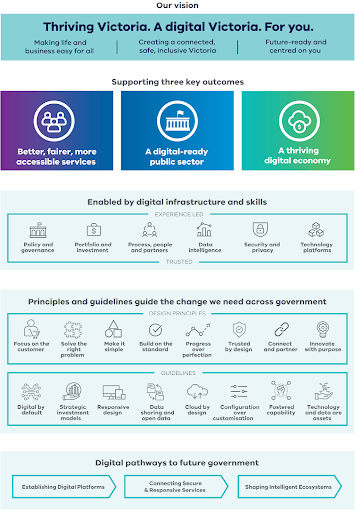
Victoria’s new digital strategy
The Victorian Government’s Digital Strategy was released last month. Its focus is on meeting the needs of Victorian citizens and businesses by “designing services around people’s lives”.
An important element is investing in digital infrastructure. The strategy makes a great comparison to traditional infrastructure: “Just as traditional infrastructure like roads, water and electricity is critical for going about our lives, strong digital infrastructure allows us to interact, create and innovate.”
The three outcomes
The strategy identifies three outcomes that the Victorian Government is focused on:
- “Better, fairer, more accessible services — making services more personalised and consistent
- A digital-ready public sector — improving operations, working collaboratively with partners and developing a workforce skilled for the future, now
- A thriving digital economy — attracting talent, upskilling our communities and businesses, creating jobs and bridging the digital divide”
Outcome 1: Better, fairer, more accessible services
This outcome will be delivered through:
- Experiences that support and empower everyone —it’s essential that all Victorians can easily access digital services.
- Low / no touch, effortless interactions — Victorians need to be able to interact with digital services quickly and easily (like they do with non-government digital services).
- Universally accessible government services — government needs to provide integrated services and a single portal for easy interactions.
- Personalisation on your terms — personalisation enhances user experience, but government must be transparent about what happens to people’s data.
- Secure, trusted and reliable services —Victorians must feel that their data is safe and secure.
Outcome 2: A digital-ready public sector
This outcome will be delivered through:
- Evidence-based decision-making and co-designed policy — using data to drive policy and service design.
- Responsive, resilient, connected government — governments with a shared vision can deliver improved services at a lower cost.
- Simplified operations that maximise human talent — driving efficiency through common, connected platforms, cloud-based platforms and process redesign including automation.
- Digital mindsets, skills and ways of working — digital upskilling especially across data analysis.
- Digital ethics, privacy and security — ethical foundations ensure citizen trust.
Outcome 3: A thriving digital economy
This outcome will be delivered through:
- Digital literacy and inclusion — digital literacy is essential for a thriving digital economy.
- A connected, thriving regional and rural economy — the digital gap between rural/regional areas and metropolitan areas needs to be addressed to give everyone access to digital services.
- Seamless digital interactions with business and beyond — enabling partnerships by simplifying how government does business.
- Future-ready, resilient industries — driving research and innovation to support business and help make them resilient.
- A magnet for talent and investment — attracting talent to help create a thriving digital economy.
Six strategic enablers
To help deliver on these three outcomes, the strategy outlines six strategic enablers:
- Ensuring policy and governance enables digital transformation
- Using a more agile approach to portfolio and investment
- ‘Digital inside and out’ across processes, people and partners
- Using data for improved insights and outcomes
- Focusing on security and privacy
- Modern technology platforms
Design principles
The Victorian Government has also identified design principles as essential to delivering on the vision and outcomes. The design principles are:
- Meeting citizens’ needs
- Solving the right problems
- Reducing complexity
- Creating scalable digital solutions that are cloud-first
- Focusing on progress rather than perfection
- Designing secure solutions
- Connecting, engaging and partnering with the Victorian community
- Delivering outcomes faster and with lower risks and lower costs
Digital technology guidelines
Alongside the strategic drivers and design principles are digital technology guidelines. These technology guidelines are:
- Digital by default — creating services on digital platforms
- Selecting software following a four-step process (“reuse before rent before buy before build”) so building from scratch is the last resort
- Responsive design so services meet users’ situations (e.g. the device they’re using)
- Sharing information and data to deliver value
- Designing infrastructure and platforms for cloud, unless cloud is unsuitable
- Configuring software rather than customising it
- Creating user experiences based on human-centred skills
- Using technology and data as assets
Digital pathways
The strategy also identifies three digital pathways:
- Digital platforms
- Connecting services
- Shaping ecosystems
A visual of the strategy
Below is a screenshot from page 11 of the strategy, which provides a great visual overview of the strategy and key components.
Salsa Digital’s take
The above coverage of the strategy only provides a high level overview, and we recommend you read the whole Victorian Government’s Digital Strategy . The strategy’s plans and recommendations will uplift the significant work that has already been done in delivering digital services to Victorians.
There are many areas of the strategy that align with Salsa’s vision for the future, in terms of our own company vision and our vision for government in Australia (and around the world!). We’ve devoted the past 4-5 years to helping governments become more open, more connected and more consolidated. Many of Salsa’s key initiatives, past and present, align with the strategy. We’re looking forward to continuing to work with the Victorian Government to deliver on this vision, by further crafting our domain expertise, further developing our suite of open source products, and fine-tuning our services.

